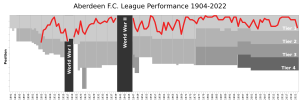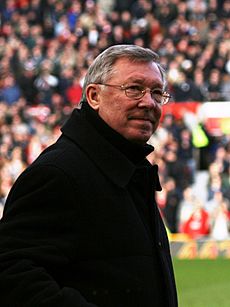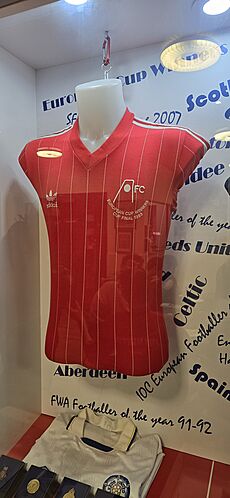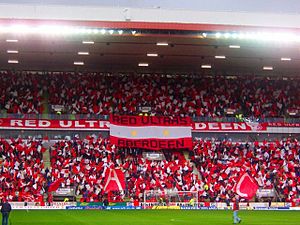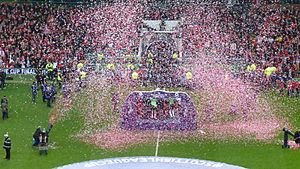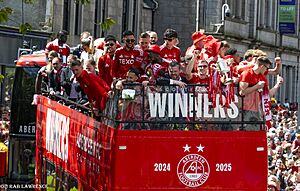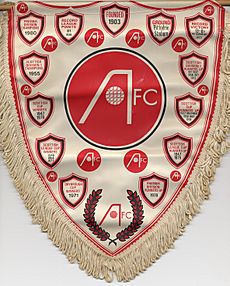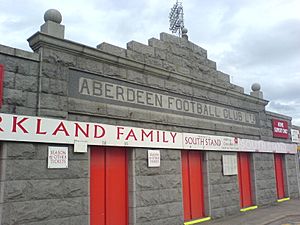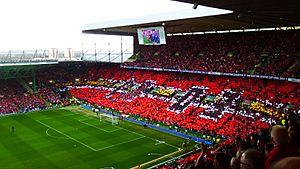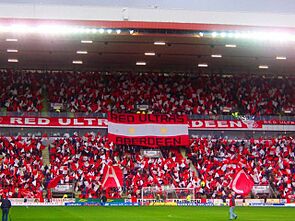Aberdeen F.C. facts for kids
 |
||||
| Full name | Aberdeen Football Club | |||
|---|---|---|---|---|
| Nickname(s) | The Dons, The Dandies, The Reds | |||
| Founded | 14 April 1903 | |||
| Ground | Pittodrie Stadium | |||
| Capacity | 20,866 | |||
| Chairman | Dave Cormack | |||
| Manager | Jimmy Thelin | |||
| League | Scottish Premiership | |||
| 2015–16 | Scottish Premiership, 2nd | |||
|
||||
Aberdeen Football Club is a professional football team from Aberdeen, Scotland. They play in the top league of Scottish football and have never been moved down to a lower division since joining the top league in 1905. Aberdeen has won many important trophies. They have won the Scottish league title four times, the Scottish Cup eight times, and the Scottish League Cup six times. They are also the only Scottish team to win two European trophies: the European Cup Winners' Cup and the European Super Cup, both in 1983.
The club was started in 1903 when three local Aberdeen teams joined together. They didn't win many major trophies until after World War II. During the 1980s, under manager Alex Ferguson, Aberdeen had their most successful period. They won three league titles, four Scottish Cups, one Scottish League Cup, and their two European trophies. Aberdeen was the last team outside of the "Old Firm" (Celtic and Rangers) to win a league title, which happened in 1985. They were also the last Scottish team to win a European trophy. After this "golden era," the team had less success. However, they won the 2013–14 Scottish League Cup in 2014, ending a 19-year wait for a major trophy. They also finished second in the league several times in the 2010s and won the 2024–25 Scottish Cup in 2025, their first Scottish Cup win in 35 years.
Aberdeen has played at Pittodrie Stadium since the club began. The stadium can hold 20,866 fans. It was the first stadium in the United Kingdom where all seats were covered. Pittodrie was also the first football stadium to have a "dug-out," which is a special area for coaches and players. This idea was created by player and coach Donald Colman.
The team's main colours have been red and white since 1939. Before that, they wore black and gold stripes. Today, Aberdeen mostly plays in all-red uniforms with white details. Aberdeen gets support from fans in the city and nearby areas because there are no other big football teams very close by. Instead of local rivals, Aberdeen has rivalries with teams like Dundee United (known as the "New Firm" in the 1980s) and Rangers.
Contents
Club History
Early Years (1903–1939)
The Aberdeen Football Club we know today was formed in 1903. It was created by combining three smaller clubs from the city: Aberdeen, Victoria United, and Orion. The new club played its first game on August 15, 1903, a 1–1 draw against Stenhousemuir. In their first season, they won the Aberdeenshire Cup.
In 1904, Jimmy Philip became the club's manager. Even though they finished seventh in their league, Aberdeen was chosen to join the new, bigger First Division. They have stayed in the top league of Scottish football ever since. From 1906, the club slowly got better. They reached the Scottish Cup semi-finals in 1908 and again in 1911. In the 1910–11 season, Aberdeen beat Celtic and Rangers for the first time. They even led the league for a while but finished in second place.
World War I made things difficult for the club. By 1917, Aberdeen stopped playing in competitive football, along with Dundee and Raith Rovers. Senior football returned on August 16, 1919. Jimmy Philip was still in charge. His team could win some games but couldn't win a trophy. In 1923, Aberdeen played Peterhead in the Scottish Cup and won 13–0. This is still their record score. Philip retired a year later, and Paddy Travers became the new manager. He led the team to their first Scottish Cup final in 1937.
Donald Colman, a former player, was Travers' "trainer" (like a first-team coach today). Colman invented the "dug-out," a covered area slightly below the field. This helped him watch the game better. Everton visited Pittodrie soon after it was introduced and took the idea to England. From there, it spread around the world. Travers left to manage Clyde in 1939.
Winning Trophies (1939–1978)
Dave Halliday became manager in 1939, and the club changed its colours from black and gold to red and white. Halliday's work was paused when World War II stopped football in the UK. During the war, directors Charles B Forbes and George Anderson temporarily ran the club while Halliday served in the war.
After the war, Halliday became famous for bringing national trophies to Pittodrie. Aberdeen won the Southern League Cup in 1946, beating Rangers 3–2. They then reached the 1947 Scottish Cup final. They beat Hibernian 2–1, winning the club's first major trophy. Halliday's team reached two more Scottish Cup finals in 1953 and 1954 but lost both. However, in the 1954–55 season, Aberdeen won their first Scottish League title.
Halliday left in 1955, and Davie Shaw took over. Aberdeen won the Scottish League Cup in 1956 under Shaw, beating St Mirren. They also reached another Scottish Cup final in 1959. Shaw then stepped down, and Tommy Pearson became manager in 1959. Pearson's time saw many player changes, but no trophies. He retired in 1965, and Eddie Turnbull took charge.
Turnbull led Aberdeen to the 1967 Scottish Cup final, where they lost to Celtic. Even with the loss, Aberdeen qualified for the European Cup Winner's Cup the next season. This was the first time the club played in a European competition. They won their first game 14–1 against KR Reykjavik. Two years later, Derek McKay scored four goals to help his team win the 1969–70 Scottish Cup. As cup winners, Aberdeen played in the same competition again. They were knocked out after a close game with Honvéd, which was decided by the first ever penalty shoot-out in a UEFA competition.
In the 1970s, Aberdeen often competed for national trophies. However, they didn't win many, except for the Drybrough Cup in 1971 and the League Cup in 1976. During this time, Aberdeen had five different managers. They reached two more national cup finals: the Scottish Cup in 1978 and the League Cup in 1979.
The Alex Ferguson Era (1978–1986)
Under manager Alex Ferguson, Aberdeen won many trophies in just seven years. This included three league championships, four Scottish Cups, one League Cup, the European Cup Winner's Cup, and the European Super Cup. Key players like Jim Leighton, Willie Miller, Alex McLeish, and Gordon Strachan were central to the team's success.
Aberdeen won their second League title in 1980. They then won the Scottish Cup three years in a row, from 1982 to 1984. They also won two more league titles in 1984 and 1985.
In the European Cup Winners' Cup in 1983, Aberdeen beat several teams to reach the semi-finals. They faced Bayern Munich and won 3–2 at home after a 0–0 draw in Germany. John Hewitt scored the winning goal. Next, they played Waterschei in the semi-final. Aberdeen won 5–1 at home and, despite losing 1–0 away, won overall to reach the final. On May 11, 1983, Aberdeen beat Real Madrid 2–1 after extra time. This made them only the third Scottish team to win a European trophy. The club even released a song called "European Song" for the final. In December, they won the European Super Cup by beating Hamburger SV.
Aberdeen reached the semi-finals of the 1983–84 European Cup Winners' Cup but lost to Porto. In the 1984–85 European Champion Club's Cup, Aberdeen lost to BFC Dynamo in a penalty shoot-out. Today, these two clubs have a friendly relationship.
After Ferguson (1987–1999)
After Alex Ferguson left to manage Manchester United in November 1986, Aberdeen found it harder to compete with Celtic and Rangers.
In 1989, Aberdeen hired two co-managers, Alex Smith and Jocky Scott. They signed new international players. In the 1989–90 season, the club won both the Scottish Cup and the Scottish League Cup. In 1991, they lost the last game of the season to Rangers, which meant they also lost the league title.
Former player Willie Miller took over as manager in 1992. For two seasons, Aberdeen came close to winning the title. However, in the 1994–95 season, the club finished near the bottom of the league. They had to win a play-off game against Dunfermline Athletic to stay in the top division. Miller was replaced by Roy Aitken in February 1995. Even though they won the Scottish League Cup in 1995, the club continued to struggle. Alex Miller and Paul Hegarty also managed the team in the late 1990s. The club faced financial problems because of a new stadium stand. So, the directors turned to Stewart Milne, a local businessman, who became the club's chairman.
Managers and Changes (1999–2013)
Ebbe Skovdahl became Aberdeen's first foreign manager in 1999. His time saw some of the club's biggest defeats. The team finished last in the league in the 1999–2000 season. The league was expanding, so Aberdeen was supposed to play in a special play-off. However, one of the other clubs (Falkirk) didn't meet stadium rules, so Aberdeen stayed in the top league. The next season, they lost early in the UEFA Cup to Irish club Bohemians.
Steve Paterson replaced Skovdahl in 2002 but only managed for two seasons.
Jimmy Calderwood took over in 2004, and Aberdeen's results became more consistent. In the 2006–07 season, the club finished third in the league. This allowed them to enter the final qualifying round for the 2007–08 UEFA Cup. Aberdeen beat Dnipro and then F.C. Copenhagen 4–0. This was one of Pittodrie's biggest crowds since the 1980s. They then played against German giants Bayern Munich. Aberdeen lost 7–3 overall, even though they drew 2–2 in the first game. Calderwood was let go in May 2009, even after leading the club to a fourth-place finish and back into Europe. Poor results in domestic cup competitions were thought to be the reason.
Mark McGhee became manager in June 2009. Aberdeen suffered their heaviest ever defeat, 9–0, against Celtic in November 2010. McGhee was let go in December of that year.
Craig Brown took over as manager. Aberdeen did not improve much under his leadership. In March 2013, he announced his retirement to take on a different role on the club's board.
Recent Years (2013–Present)
Derek McInnes became manager in March 2013. In his first season, Aberdeen won the 2013–14 Scottish League Cup by beating Inverness on penalties. This was their first trophy in 19 years. Aberdeen finished third in the league that season. In the next seasons, they often finished second in the league behind Celtic. They also played in the UEFA Europa League several times but were usually knocked out in the qualifying rounds.
Aberdeen finished second in the league again in 2017 and reached both cup finals. However, they lost both to Celtic. They were second again the following season. In November 2019, American club Atlanta United bought a small part of Aberdeen. As part of this deal, Dave Cormack became the new chairman. McInnes left his manager role in March 2021 after almost eight years.
Over the next three years, Aberdeen had four different managers. Stephen Glass was manager but was let go in February 2022. Jim Goodwin was then sacked after a surprising loss in the Scottish Cup and a big league defeat. Barry Robson became manager in January 2023 but left in January 2024. Neil Warnock was a temporary manager. In April 2024, the club announced that Jimmy Thelin would become manager in June 2024. On May 24, 2025, Aberdeen won their first Scottish Cup in 35 years by beating Celtic on penalties.
Colours and Crest
|
|
| The "Wasps" black and gold strip, worn until 1939 |
In the club's very first season, the team wore mostly white. This was similar to the colours of the older Aberdeen club. But this colour scheme only lasted one season.
For the 1904–05 season, Aberdeen started wearing black and gold striped shirts. This led to the team being called "the Wasps." This uniform, with small changes, was worn until just before World War II. The blue shorts were replaced with white ones in 1911. Socks were black with gold trim.
|
|
| A typical post-war Aberdeen uniform. These colours were worn when they won trophies in the 1950s. |
In March 1939, Aberdeen changed their colours to red and white. These colours matched the silver and red of the official City of Aberdeen crest. The first red uniforms had white shorts, with either red or white socks. In 1966, Aberdeen started wearing red shorts, making the official uniform all-red. This is similar to Liverpool's uniform. This all-red style has continued to today, with different designs over the years. In the late 1970s, a uniform had five white stripes on the left side. The uniforms from the early 1980s had thin white vertical stripes. Later designs sometimes included blue, and for one season, they went back to white shorts. But the all-red look returned in 1997.
Teams started having sponsors on their shirts in 1987. The first sponsor for Aberdeen was JVC. Since then, many shirt sponsors have been local Aberdeen businesses, especially oil service companies. As of 2025, the current shirt sponsor is TEXO.
Away uniforms have usually been white (often with black shorts) or a mix of yellow and black. These colours refer back to the black and gold uniforms from before the war. For a time in the 1970s, Aberdeen wore an all-blue away uniform. For the 2007–08 season, the away uniform was all-white. A third uniform of yellow and black was available for European games or if both red and white clashed with another team.
The club didn't have an official crest until 1972. Before that, different versions of the letters "AFC" sometimes appeared on the shirts. In November 1972, the club showed off its official crest. It was designed by Donald Addison. The design showed a capital letter "A" that looked like the side of a football goal. A ball formed the crossbar of the "A," and it looked like it was in the net, showing a goal being scored. The letters "FC" were added below the ball. This badge was used on shirts from around 1978. In the mid-1980s, the words "Aberdeen Football Club" were added in a circle around the badge, and the founding year, 1903, was added below the goal. The current version of the crest, which keeps these parts in one design, was introduced in 1997. Two stars were added above the badge in 2005 to show that the club won two European trophies in 1983.
Kit Suppliers and Shirt Sponsors
| Period | Kit manufacturer | Shirt sponsor (front) | Shirt sponsor (sleeve) |
|---|---|---|---|
| 1975–1976 | Bukta | None | None |
| 1976–1979 | Admiral | ||
| 1979–1987 | Adidas | ||
| 1987–1990 | Umbro | JVC | |
| 1990–1993 | Abtrust | ||
| 1993–1994 | A-Fab | ||
| 1994–1996 | Northsound Radio | ||
| 1996–1997 | Living Design | ||
| 1997–1998 | Puma | ||
| 1998–2001 | Atlantic Telecom | ||
| 2001–2004 | Le Coq Sportif | A-Fab | |
| 2004–2006 | Nike | ADT | |
| 2006–2008 | Apex Tubulars | ||
| 2008–2011 | Team Recruitment | ||
| 2011–2014 | Adidas | ||
| 2014–2022 | Saltire Energy | ||
| 2022–2024 | TEXO | Tendeka | |
| 2024– | Ram Tubulars |
Stadium and Facilities
Pittodrie Stadium
Aberdeen has always played at Pittodrie Stadium. The name "Pittodrie" comes from an old language and means "place of manure." The stadium was first used by the original Aberdeen F.C. in 1899. When the new club formed in 1903, they took over the stadium. On August 15, 1903, 8,000 fans watched the new Aberdeen team draw 1–1 against Stenhousemuir. The club first rented the stadium and then bought it in 1920. The stadium can currently hold 20,866 people. The most people ever to attend a game was 45,061, during a Scottish Cup match in 1954.
The stadium has four main sections: the Main Stand, which also has the club offices; the Merkland Road Stand, also called the "Red Shed"; the South Stand, which holds the most fans; and the Richard Donald Stand, built in 1993, which has special hospitality areas. A part of the South Stand is used for visiting team supporters. In 1978, Pittodrie became the first stadium in Britain where all seats were covered.
Training Facilities
Aberdeen trains at Cormack Park, which opened on October 31, 2019. Former manager Alex Ferguson said it was "up there with the best" training facilities he had seen. Cormack Park is a training centre for the first team. It also hosts the Bobby Clark Football Academy and the AFC Community Trust. It serves as a community sports hub too. The training facilities are named after chairman Dave Cormack because he invested a lot of money to build them.
The complex has a training building, groundskeeper housing, three full-sized grass training pitches, and two floodlit 3G pitches. There are also flexible indoor and outdoor spaces for sports and recreation. All the pitches are named after club legends, chosen by fans in an online poll.
Before Cormack Park opened, the first team trained in different places around the city.
Future Stadium Plans
Since 2009, Aberdeen has been thinking about moving to a new stadium. Plans for a new stadium started because Pittodrie Stadium is old, and it's hard to develop it further due to the land around it. In May 2009, the city council approved an early plan for a new stadium near Loirston Loch.
The move was delayed in 2012 due to land ownership issues. In 2016, new plans were announced to build a stadium and training facilities near Westhill. This new stadium is expected to have a similar number of seats as Pittodrie. Although the project faced legal challenges, progress slowed down because of the economic impact of the COVID-19 pandemic. In August 2021, new designs were released for a stadium at the city's beachfront, closer to Pittodrie.
Supporters and Nicknames
Supporters
Aberdeen's supporters are known as the "Red Army." They are listed in the team squad as wearing the number 12 shirt.
Aberdeen is the only top-league team in Scotland's third-largest city. The city is quite far from other big population centres. Because of this, Aberdeen has a large area from which to draw supporters. The average attendance in the 2023–24 Scottish Premiership was 16,055.
Rivalries
Aberdeen has rarely played in the same league as its closest neighbours. So, their rivalries tend to be with teams further away.
In the early 1980s, because both Aberdeen and Dundee United were very successful, they were known as the "New Firm." However, Dundee United has its own close rivals in the city of Dundee.
Aberdeen also has a rivalry with Rangers. This rivalry grew after several incidents in games between the two clubs in the 1980s. For example, Neil Simpson's tackle on Ian Durrant in 1988. Aberdeen's success in the 1980s also played a role. There are still often clashes between both sets of supporters today.
Aberdeen developed a smaller rivalry with Inverness Caledonian Thistle after Inverness was promoted to the top league in 2004. This is known as the "North derby" because Aberdeen and Inverness are the two largest cities in the north of Scotland.
As Aberdeen became one of the top teams in Scotland again in the 2010s, the rivalry with Celtic grew stronger.
Nicknames
Aberdeen is known as "The Dons." This name has been used since at least 1913. No one is completely sure where this nickname came from. One idea is that it comes from the word "don," meaning "teacher," because Aberdeen is a university city. It might also refer to the nearby River Don, or be a shorter version of "Aberdonians." Before "The Dons" became popular, the team was called "The Wasps" or "The Black and Golds," because of their yellow and black striped uniforms. Like many teams that wear red, Aberdeen can also be called "The Reds." Some fans also call them "The Dandy Dons" or "The Dandies."
Sometimes, rival clubs call Aberdeen "The Sheep" and their supporters "The Sheep Shaggers." This term was eventually accepted by the club's supporters. Fans even started chanting "the sheep are on fire" at games. This led to special merchandise being sold by the club and local businesses.
Songs
Football chants and songs include "The Northern Lights of Old Aberdeen" and "Stand Free." The song "Stand Free" uses the tune of "Lord of the Dance."
Ultras
Aberdeen has had a few fan groups called "ultras" over the years. In 1999, a group of supporters formed the "Red Ultras." This group created displays, like their "one love" display. The Red Ultras stopped being active in early 2010.
After the "Red Shed" section of the stadium was created, a new group called "Ultras Aberdeen" formed in 2022. They have made displays, such as the "Heroes" display, to honor the team that won the 1983 European Cup Winners' Cup final. There was also a display at Hampden Park for the 2023 Viaplay League Cup final against Rangers. The group also uses large flags and pyrotechnics like smoke bombs and flares.
Players
Current Squad
|
|
Players on Loan
|
|
Famous Players
- Hall of Fame
Aberdeen started a Hall of Fame in 2003 to celebrate the club's 100th birthday. Six players were added in 2004, and six more later that year. Former manager Alex Ferguson was added in 2015.
In 2017, Neale Cooper, Archie Knox, John McMaster, and Graham Leggat joined the Hall of Fame. In 2018, Eoin Jess, Peter Weir, Bobby Clark, and Donald Colman were added. Matt Armstrong, Brian Irvine, Hans Gillhaus, and Charlie Nicholas were added in January 2025.
|
|
- Greatest Team Ever
In November 2015, fans voted to choose the greatest Aberdeen team of all time.
 Jim Leighton (1977–88, 1997–2000)
Jim Leighton (1977–88, 1997–2000) Stuart Kennedy (1976–83)
Stuart Kennedy (1976–83) Willie Miller (1972–90)
Willie Miller (1972–90) Alex McLeish (1978–94)
Alex McLeish (1978–94) Russell Anderson (1996–2007, 2012–15)
Russell Anderson (1996–2007, 2012–15) Gordon Strachan (1977–84)
Gordon Strachan (1977–84) Eoin Jess (1987–96, 1997–2001)
Eoin Jess (1987–96, 1997–2001) Jim Bett (1985–94)
Jim Bett (1985–94) Neil Simpson (1980–90)
Neil Simpson (1980–90) Joe Harper (1969–72, 1976–81)
Joe Harper (1969–72, 1976–81) Duncan Shearer (1992–97)
Duncan Shearer (1992–97)
Club Officials
Technical Staff
Management
|
Managers
This list shows full-time managers and their league match records, as of January 25, 2025. Temporary managers are not included.
| From | To | Name | P | W | D | L | Win% | Ref |
|---|---|---|---|---|---|---|---|---|
| 1903 | 1924 | 644 | 221 | 172 | 251 | 34.32 | ||
| 1924 | 1937 | 474 | 214 | 106 | 154 | 45.15 | ||
| 1937 | 1955 | 371 | 165 | 71 | 135 | 44.47 | ||
| 1955 | 1959 | 148 | 66 | 20 | 62 | 44.59 | ||
| 1959 | 1965 | 180 | 66 | 42 | 72 | 36.67 | ||
| 1965 | 1971 | 216 | 101 | 43 | 72 | 46.76 | ||
| 1971 | 1975 | 143 | 67 | 46 | 30 | 46.85 | ||
| 1975 | 1977 | 61 | 24 | 19 | 18 | 39.34 | ||
| 1977 | 1978 | 36 | 22 | 9 | 5 | 61.11 | ||
| 1978 | 1986 | 288 | 167 | 71 | 50 | 57.99 | ||
| 1986 | 1986 | 15 | 7 | 5 | 3 | 46.67 | ||
| 1986 | 1988 | 71 | 35 | 27 | 9 | 49.30 | ||
| 1988 | 1991 | 117 | 63 | 35 | 19 | 53.85 | ||
| 1991 | 1992 | 23 | 7 | 7 | 9 | 30.43 | ||
| 1992 | 1995 | 126 | 54 | 46 | 26 | 42.86 | ||
| 1995 | 1997 | 100 | 35 | 28 | 37 | 35.00 | ||
| 1997 | 1998 | 38 | 10 | 11 | 17 | 26.32 | ||
| 1999 | 2002 | 130 | 40 | 31 | 59 | 30.77 | ||
| 2002 | 2004 | 57 | 18 | 10 | 29 | 31.58 | ||
| 2004 | 2009 | 190 | 79 | 49 | 62 | 41.58 | ||
| 2009 | 2010 | 53 | 13 | 12 | 28 | 24.53 | ||
| 2010 | 2013 | 93 | 27 | 29 | 37 | 29.03 | ||
| 2013 | 2021 | 295 | 157 | 60 | 78 | 53.22 | ||
| 2021 | 2022 | 29 | 9 | 6 | 14 | 31.03 | ||
| 2022 | 2023 | 35 | 11 | 7 | 17 | 31.43 | ||
| 2023 | 2024 | 36 | 15 | 7 | 14 | 41.67 | ||
| 2024 | Present | 38 | 15 | 8 | 15 | 39.47 |
Honours
| Type | Competition | Titles | Seasons |
|---|---|---|---|
| Domestic | Scottish League | 4 | 1954–55, 1979–80, 1983–84, 1984–85 |
| Scottish Cup | 8 | 1946–47, 1969–70, 1981–82, 1982–83, 1983–84, 1985–86, 1989–90, 2024–25 | |
| Scottish League Cup | 6 | 1955–56, 1976–77, 1985–86, 1989–90, 1995–96, 2013–14 | |
| Continental | UEFA Cup Winners' Cup | 1 | 1982–83 |
| UEFA Super Cup | 1 | 1983 |
Other Awards
- France Football European Team of the Year: 1
-
- 1983
- The club was given the Freedom of the City of Aberdeen on December 16, 2022. This was decided by a vote from the Aberdeen City Council.
Records
Individual Player Records
All players are from Scotland unless noted. These records are for competitive, professional matches only, up to the end of the 2022–23 season.
- Top Goalscorers
| Rank | Name | Career | Apps | Goals | Average |
|---|---|---|---|---|---|
| 1 | Joe Harper | 1969–1973, 1976–1981 | 300 | 199 | 0.66 |
| 2 | Matt Armstrong | 1931–1939, 1945–1946 | 219 | 156 | 0.71 |
| 3 | George Hamilton | 1938–1939, 1945–1955 | 284 | 155 | 0.55 |
| 4 | Harry Yorston | 1947–1957 | 278 | 141 | 0.51 |
| 5 | Drew Jarvie | 1972–1982 | 386 | 131 | 0.34 |
| 6 | Benny Yorston | 1927–1932 | 156 | 124 | 0.79 |
| 7 | Willie Mills | 1932–1938 | 210 | 114 | 0.54 |
| 8 | Jack Hather |
1948–1960 | 351 | 105 | 0.30 |
| 9 | Mark McGhee | 1978–1984 | 249 | 100 | 0.4 |
| 10= | Billy Little | 1957–1968 | 306 | 98 | 0.32 |
| Davie Robb | 1966–1978 | 345 | 98 | 0.28 |
- Most Appearances
| Rank | Name | Career | Apps | Goals |
|---|---|---|---|---|
| 1 | Willie Miller | 1972–1990 | 796 | 32 |
| 2 | Alex McLeish | 1978–1994 | 689 | 30 |
| 3 | Bobby Clark | 1965–1980 | 591 | 0 |
| 4 | Andrew Considine | 2004–2022 | 571 | 41 |
| 5 | Stewart McKimmie | 1983–1997 | 562 | 9 |
| 6 | Jim Leighton | 1977–1988, 1997–2000 | 533 | 0 |
| 7 | Russell Anderson | 1996–2007, 2011–2015 | 407 | 21 |
| 8 | Drew Jarvie | 1972–1982 | 386 | 131 |
| 9 | Brian Irvine | 1985–1997 | 385 | 40 |
| 10 | Eoin Jess | 1989–1996, 1997–2001 | 380 | 94 |
Images for kids
See also
 In Spanish: Aberdeen Football Club para niños
In Spanish: Aberdeen Football Club para niños
- Aberdeen F.C. Women


